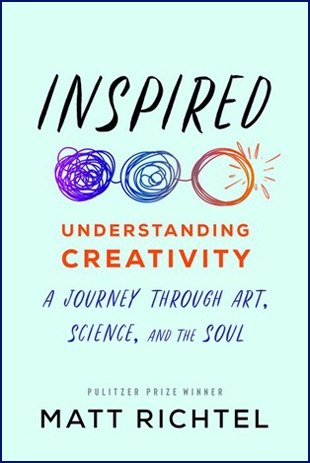The author of this book, Matt Richtel, won a Pulitzer Prize for a series of articles he wrote at the New York Times on distracted driving habits in America. He approaches his topics in the manner of a skilled reporter, and this book is no different.
Richtel goes deeply into various expressions of human creativity, including the arts, sciences, and spirituality. He explores where creative ideas originate, how they grow, and what environments best cultivate them.
“Creativity is not mere habit,” he writes. “How creators do it has become the source of a growing body of scholarship. We are learning, through creative research — powered by innovative technology — how to wield our creative power with greater precision.”
He intends the book to give hope in troubled times, and that was certainly our experience reading it. As Richtel writes, “This book is good news … the promise that new ideas will come again and again, as inevitable as the ocean waves and the up and down path of the sun.”
Chapters recount many travels and meetings with creative people around the world. Always, Richtel asks good questions, to get to the heart of what inspires inspiring people. He interviews neuroscientists, psychologists, entrepreneurs, theologians and religious reformers, inventors, novelists, physicians, and many other creators.
The people you meet are both ordinary and fascinating. They are often creating out of desperation or to satisfy an emotional need. Sometimes a creator is going completely “against the grain” of their culture or their industry or science. The inspirations for creativity are as diverse as are people.
Often, there are warnings to would-be creatives, such as: “Doubt can kill creativity, or at least inhibit it. By contrast creativity can be inspired by terror…. Creators embrace … fear as one ingredient on the spice rack, as one of the multitudes a creator contains. They tap into fear as an emotion, an underlying state, a thing to be acknowledged or tapped into, watered, tended, drawn from.”
In a late chapter, four qualities of creativity are identified. These are (1) fluency — a capacity for having lots of ideas, (2) originality — thinking that is fresh or unique, (3) flexibility — the ability to “move” once inspired, and (4) detail — having not just “big” ideas but being able to break them down into finer points.
He looks, too, at how communities sometimes foster creativity: Renaissance Florence, nineteenth century Paris, Chinese dynasties, and certain modern research institutes. Many creatives from centuries past are examined in detail. “We were born to create,” the author says, at one point, about every person living.
